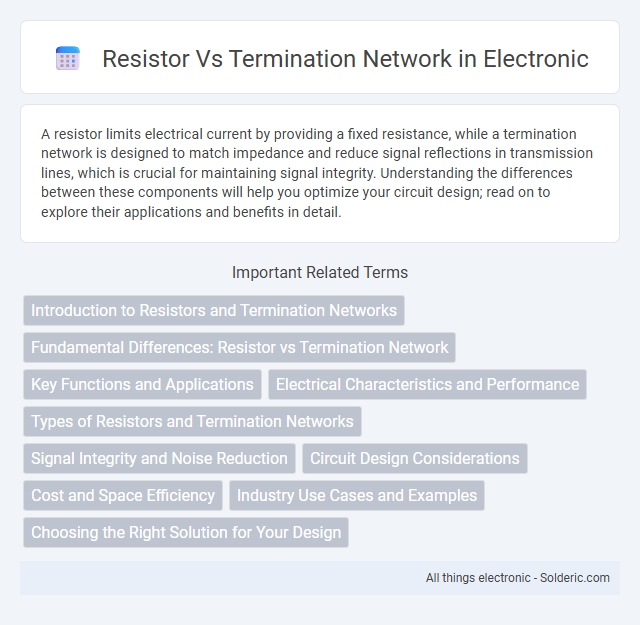A resistor limits electrical current by providing a fixed resistance, while a termination network is designed to match impedance and reduce signal reflections in transmission lines, which is crucial for maintaining signal integrity. Understanding the differences between these components will help you optimize your circuit design; read on to explore their applications and benefits in detail.
Comparison Table
| Feature | Resistor | Termination Network |
|---|---|---|
| Purpose | Limits current, divides voltage | Minimizes signal reflection and noise in high-speed lines |
| Typical Components | Single resistor element | Combination of resistors, capacitors, and/or inductors |
| Application | General electronic circuits | Signal integrity in transmission lines (e.g., Ethernet, CAN bus) |
| Impedance Matching | No impedance matching function | Designed to match characteristic impedance (e.g., 50O, 120O) |
| Signal Reflection | Does not specifically prevent reflections | Prevents or reduces signal reflections at line ends |
| Complexity | Simple, low-cost | More complex, costlier |
| Usage Example | Voltage divider, current limiter | Bus termination for CAN, Ethernet terminations |
Introduction to Resistors and Termination Networks
Resistors are passive electrical components that limit electric current and divide voltage in circuits, playing a fundamental role in controlling signal flow and protecting components. Termination networks, often implemented using resistors, are specialized circuits designed to match impedance and minimize signal reflections in high-frequency transmission lines. Understanding the distinction between simple resistors and complex termination networks helps optimize your electronic design for signal integrity and performance.
Fundamental Differences: Resistor vs Termination Network
A resistor is a single passive electrical component designed to limit current and divide voltage within a circuit. In contrast, a termination network consists of multiple elements, such as resistors, capacitors, or inductors, arranged to match impedance and minimize signal reflections in communication or transmission lines. The fundamental difference lies in the resistor's simple, singular function versus the termination network's complex role in optimizing signal integrity.
Key Functions and Applications
Resistors primarily provide precise control of current and voltage within electronic circuits, often used to limit current or divide voltage. Termination networks stabilize signal integrity by preventing reflections in high-speed communication lines, crucial in data transmission systems like Ethernet or CAN bus. Understanding these key functions helps you select the right component for controlling electrical behavior or ensuring reliable signal performance in your designs.
Electrical Characteristics and Performance
Resistors provide fixed resistance values that limit current flow and stabilize voltage in circuits, but termination networks combine resistors with capacitors or inductors to better manage signal integrity by reducing reflections and impedance mismatches. Termination networks improve high-frequency performance and minimize signal distortion more effectively than simple resistors, ensuring better data transmission in high-speed communication systems. Your choice between a resistor and a termination network depends on the required electrical characteristics, such as frequency range, noise suppression, and signal fidelity.
Types of Resistors and Termination Networks
Types of resistors include fixed, variable, and precision resistors, each designed to control current and voltage in circuits with exact resistance values. Termination networks often utilize resistor arrays such as pull-up, pull-down, and voltage divider resistors configured to prevent signal reflection and ensure impedance matching in high-speed digital and analog communication lines. Common termination methods include parallel, series, and Thevenin termination networks, combining resistors strategically to optimize signal integrity and minimize electromagnetic interference.
Signal Integrity and Noise Reduction
Resistors in termination networks help maintain signal integrity by matching impedance and preventing signal reflections along transmission lines. Proper termination with resistor arrays minimizes noise and crosstalk, ensuring cleaner data signals in high-speed communication systems. Your circuit's performance improves significantly when termination networks are designed to optimize both signal integrity and noise reduction.
Circuit Design Considerations
Resistor and termination networks play crucial roles in circuit design, ensuring signal integrity and minimizing reflection in high-speed digital systems. Resistor networks often provide simplistic termination but may introduce signal attenuation, while termination networks, including RC or RC-CR configurations, offer tailored impedance matching for better noise reduction and signal stability. Your choice depends on the trade-off between power consumption, signal quality, and layout complexity for optimal performance.
Cost and Space Efficiency
Resistor termination networks generally offer lower cost and simpler implementation compared to complex termination networks, making them ideal for budget-sensitive applications. They also occupy less PCB space due to fewer components, enhancing space efficiency in compact electronic designs. Optimizing resistor values helps maintain signal integrity while minimizing overall expenses and footprint.
Industry Use Cases and Examples
Resistors are widely used in electronic circuits for current limiting, voltage division, and signal conditioning across various industries such as consumer electronics, automotive, and telecommunications. Termination networks, commonly employed in high-speed data transmission and communication systems, prevent signal reflection and ensure signal integrity in applications like Ethernet, USB, and HDMI interfaces. Industrial examples include resistive terminations in networking switches, precision resistors in sensor calibration for automotive systems, and termination networks in high-frequency PCB designs for aerospace communication modules.
Choosing the Right Solution for Your Design
Selecting between a resistor and a termination network depends on signal integrity requirements and system complexity. A simple resistor termination offers cost-effective reflection reduction in low-frequency or short-distance applications, while a termination network, such as a parallel RC or Thevenin configuration, provides superior impedance matching and noise suppression in high-speed or high-frequency circuits. Evaluating parameters like signal rise time, trace length, and system noise tolerance ensures optimal choice for minimizing signal degradation and maintaining data integrity.
resistor vs termination network Infographic

 solderic.com
solderic.com